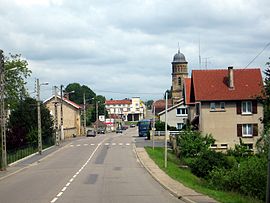Stenay
show This article may be expanded with text translated from the corresponding article in French. (August 2019) Click [show] for important translation instructions. |
Stenay | |
|---|---|
 A general view of Stenay | |
 Coat of arms | |
show Location of Stenay | |
 Stenay | |
| Coordinates: 49°29′27″N 5°11′11″E / 49.4908°N 5.1864°ECoordinates: 49°29′27″N 5°11′11″E / 49.4908°N 5.1864°E | |
| Country | France |
| Region | Grand Est |
| Department | Meuse |
| Arrondissement | Verdun |
| Canton | Stenay |
| Government | |
| • Mayor (2020–2026) | Stéphane Perrin[1] |
| Area 1 | 27.16 km2 (10.49 sq mi) |
| Population (Jan. 2018)[2] | 2,520 |
| • Density | 93/km2 (240/sq mi) |
| Time zone | UTC+01:00 (CET) |
| • Summer (DST) | UTC+02:00 (CEST) |
| INSEE/Postal code | 55502 /55700 |
| Elevation | 163–303 m (535–994 ft) |
| 1 French Land Register data, which excludes lakes, ponds, glaciers > 1 km2 (0.386 sq mi or 247 acres) and river estuaries. | |
Stenay (French pronunciation: [stənɛ]) is a commune in the Meuse department in Grand Est in north-eastern France.
Its inhabitants are called Stenaisiens.[3]
History[]

It was one of the last villages to experience fighting during the First World War.[4] Stenay was captured on 11 November 1918 by the American 89th Division under General William M. Wright only hours before the Armistice went into effect. The 89th lost 365 men to howitzer fire.[5]
Toponymy[]
According to local tradition in antiquity, the village is named after a local temple of Saturn. The name has changed significantly over time, starting with Sathanagium and Astenidum, and, through natural language change, resulting in Stenay.
The progression of names is as follows:[6][7]
- Sathanagium, Sathonagium (714)
- Astenidum (877)
- Astanid (888)
- Satenaium (900s)
- Sathaniacum (900s)
- Sathinidium (1036)
- Sathanacum (1069)
- Setunia (1000s)
- Sathanacum villam (1079)
- Satiniacum, Sathiniacum (1086)
- Sathanaco (1108)
- Sathanacensi (1157)
- Sathaniaco (1159)
- Sathanai (1173)
- Sethenac (1208)
- Settenai (1243)
- Sethenai (1264)
- Sathenay (1276, 1399, 1463, 1483, 1549, 1558, 1585)
- Sathanay (1284)
- Satenay (1399)
- Astenæum (1580)
- Satanagus (1630)
- Satanay, Sthenay (1643)
- Stenay (1793).
Tourism[]
The (Musée Européen de la bière), founded in 1986, is considered the largest of its kind on the continent.[8][9][10]
See also[]
References[]
- ^ "Répertoire national des élus: les maires". data.gouv.fr, Plateforme ouverte des données publiques françaises (in French). 2 December 2020.
- ^ "Populations légales 2018". INSEE. 28 December 2020.
- ^ Gentilé on the web site www.habitants.fr. Accessed 5 January 2016.
- ^ John Hayes-Fisher , "The last soldiers to die in World War I", BBC News Magazine, 29 October 2008
- ^ Joseph E. Persico. Wright's stated reason for the attack was because "the division had been in the line a considerable period without proper bathing facilities, and since it was realized that if the enemy were permitted to stay in Stenay, our troops would be deprived of the probable bathing facilities there." World War I: Wasted Lives on Armistice Day. History Net.
- ^ Félix Liénard, Topographical Dictionary of the Meuse Department , 1872.
- ^ Des villages de Cassini aux communes d'aujourd'hui: Commune data sheet Stenay, EHESS. (in French)
- ^ "Musée de la bière". Retrieved 2018-08-31.
- ^ "Meuse tourism". Retrieved 2018-08-31.
- ^ "Meuse tourism". Retrieved 2018-08-31.
External links[]
| Wikimedia Commons has media related to Stenay. |
- Stenay tourist office
- Stenay and the Myth
- Moulin le Cygne the Myth of Satan [ web.archive.org] History of the town
- Communes of Meuse (department)
- Champagne (province)
- Priory of Sion hoax
- Meuse (department) geography stubs



